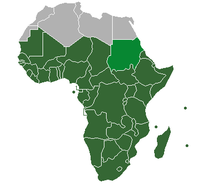
Photo from wikipedia
Across pastoralist groups, dairy products often fulfill major nutritional, economic, and socio-cultural functions. These contributions are jeopardized by poor milk quality with studies among pastoralist groups showing dairy products can… Click to show full abstract
Across pastoralist groups, dairy products often fulfill major nutritional, economic, and socio-cultural functions. These contributions are jeopardized by poor milk quality with studies among pastoralist groups showing dairy products can harbour a long list of pathogens. These potential risks underscore the need for more effective dairy hygiene interventions. Here, we determine how health messages advocating the “novel” method of pasteurization versus boiling, and administered in narrative versus technical formats, can have an impact on hygiene practices and milk quality in Maasai pastoralists. Four Maasai villages in northern Tanzania were purposively selected to receive intervention strategies that varied in message format (narrative or technical) and heat treatment advocated (boiling or pasteurization). Census lists were used to randomly select 30–35 households in each village (N = 125). Across three visits, milk hygiene knowledge and attitudes were monitored, hygiene practices were directly measured by smart thermometers that recorded heat treatment, and milk quality was determined by calculating total bacterial counts (TBCs) (N = 1007). Compared to initial levels, TBCs in the pasteurization-narrative village (N = 33) exhibited a 73.4% decrease (OR 0.148–0.480) after 7 days and a 59.1% decrease (OR 0.216–0.734) after 14 days. The boiling-narrative (N = 28) exhibited a significant decrease at 7 days (− 68.8%, OR 0.161–0.606), but this decrease was not significant after 14 days (− 35.5%, OR 0.322–1.253). There were no significant decreases for the pasteurization-technical (N = 29) or boiling-technical (N = 31) villages after 7 or 14 days. In addition, narrative health formats led to significantly greater retention of health messages and peer-to-peer sharing. Interventions to improve milk quality in pastoralist and other livestock-dependent communities may benefit from enabling the “novel” method of pasteurization. More broadly, our results suggest that the use of narrative messages can promote healthy behaviours when cultural norms are contrary to best health practices as well as enhance the sustainability and scalability of interventions targeted at hard-to-reach populations, including most pastoralist communities.
Journal Title: Pastoralism
Year Published: 2019
Link to full text (if available)
Share on Social Media: Sign Up to like & get
recommendations!